Business Communication Report: Negotiation, Presentations, Documents
VerifiedAdded on 2020/10/04
|10
|2926
|51
Report
AI Summary
This report provides a comprehensive overview of business communication principles, focusing on four key areas. Firstly, it delves into the importance of negotiation in a business environment, exploring different approaches like distributive and integrative negotiation, and outlining the components of negotiation tactics. Secondly, the report discusses various types of presentations, including persuasive and instructional presentations, detailing the resources and methods for effective delivery, and the use of feedback. Thirdly, it examines bespoke business documents, their characteristics, creation factors, legal requirements, techniques, and approval processes. Finally, the report addresses information system development, including its stages, benefits, limitations, and legal and security requirements. The report uses Buxton building contractors as a case study throughout.
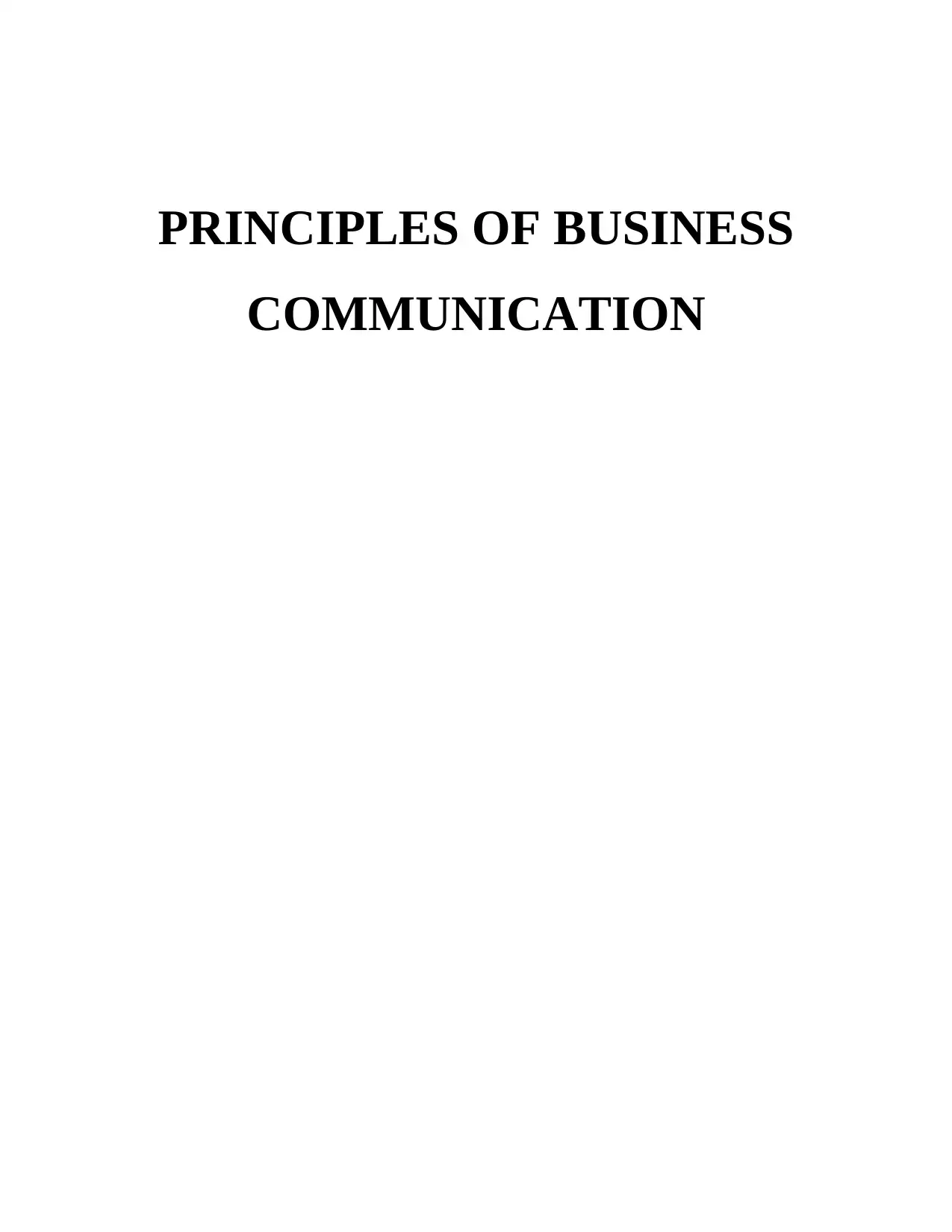
PRINCIPLES OF BUSINESS
COMMUNICATION
COMMUNICATION
Paraphrase This Document
Need a fresh take? Get an instant paraphrase of this document with our AI Paraphraser
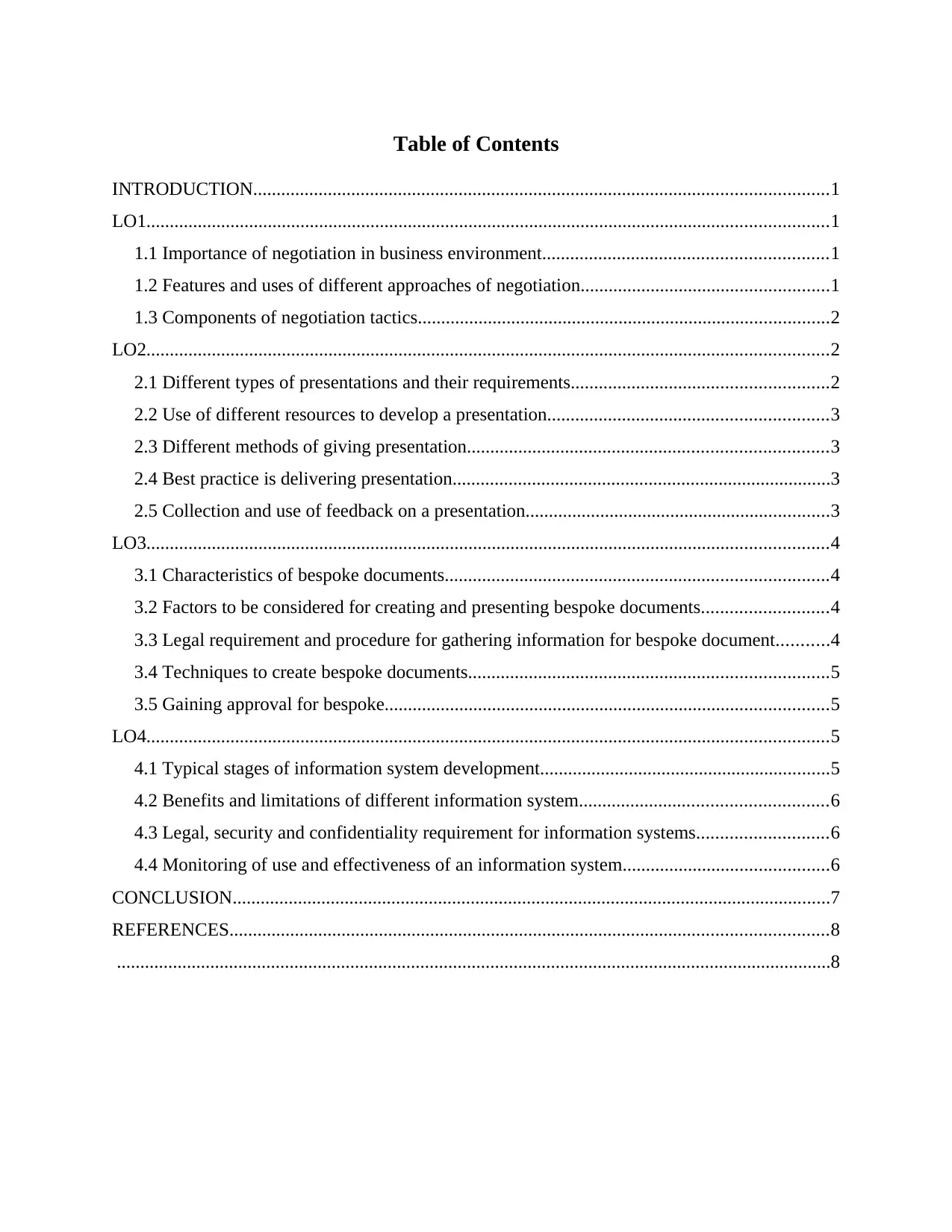
Table of Contents
INTRODUCTION...........................................................................................................................1
LO1..................................................................................................................................................1
1.1 Importance of negotiation in business environment.............................................................1
1.2 Features and uses of different approaches of negotiation.....................................................1
1.3 Components of negotiation tactics........................................................................................2
LO2..................................................................................................................................................2
2.1 Different types of presentations and their requirements.......................................................2
2.2 Use of different resources to develop a presentation............................................................3
2.3 Different methods of giving presentation.............................................................................3
2.4 Best practice is delivering presentation.................................................................................3
2.5 Collection and use of feedback on a presentation.................................................................3
LO3..................................................................................................................................................4
3.1 Characteristics of bespoke documents..................................................................................4
3.2 Factors to be considered for creating and presenting bespoke documents...........................4
3.3 Legal requirement and procedure for gathering information for bespoke document...........4
3.4 Techniques to create bespoke documents.............................................................................5
3.5 Gaining approval for bespoke...............................................................................................5
LO4..................................................................................................................................................5
4.1 Typical stages of information system development..............................................................5
4.2 Benefits and limitations of different information system.....................................................6
4.3 Legal, security and confidentiality requirement for information systems............................6
4.4 Monitoring of use and effectiveness of an information system............................................6
CONCLUSION................................................................................................................................7
REFERENCES................................................................................................................................8
.........................................................................................................................................................8
INTRODUCTION...........................................................................................................................1
LO1..................................................................................................................................................1
1.1 Importance of negotiation in business environment.............................................................1
1.2 Features and uses of different approaches of negotiation.....................................................1
1.3 Components of negotiation tactics........................................................................................2
LO2..................................................................................................................................................2
2.1 Different types of presentations and their requirements.......................................................2
2.2 Use of different resources to develop a presentation............................................................3
2.3 Different methods of giving presentation.............................................................................3
2.4 Best practice is delivering presentation.................................................................................3
2.5 Collection and use of feedback on a presentation.................................................................3
LO3..................................................................................................................................................4
3.1 Characteristics of bespoke documents..................................................................................4
3.2 Factors to be considered for creating and presenting bespoke documents...........................4
3.3 Legal requirement and procedure for gathering information for bespoke document...........4
3.4 Techniques to create bespoke documents.............................................................................5
3.5 Gaining approval for bespoke...............................................................................................5
LO4..................................................................................................................................................5
4.1 Typical stages of information system development..............................................................5
4.2 Benefits and limitations of different information system.....................................................6
4.3 Legal, security and confidentiality requirement for information systems............................6
4.4 Monitoring of use and effectiveness of an information system............................................6
CONCLUSION................................................................................................................................7
REFERENCES................................................................................................................................8
.........................................................................................................................................................8
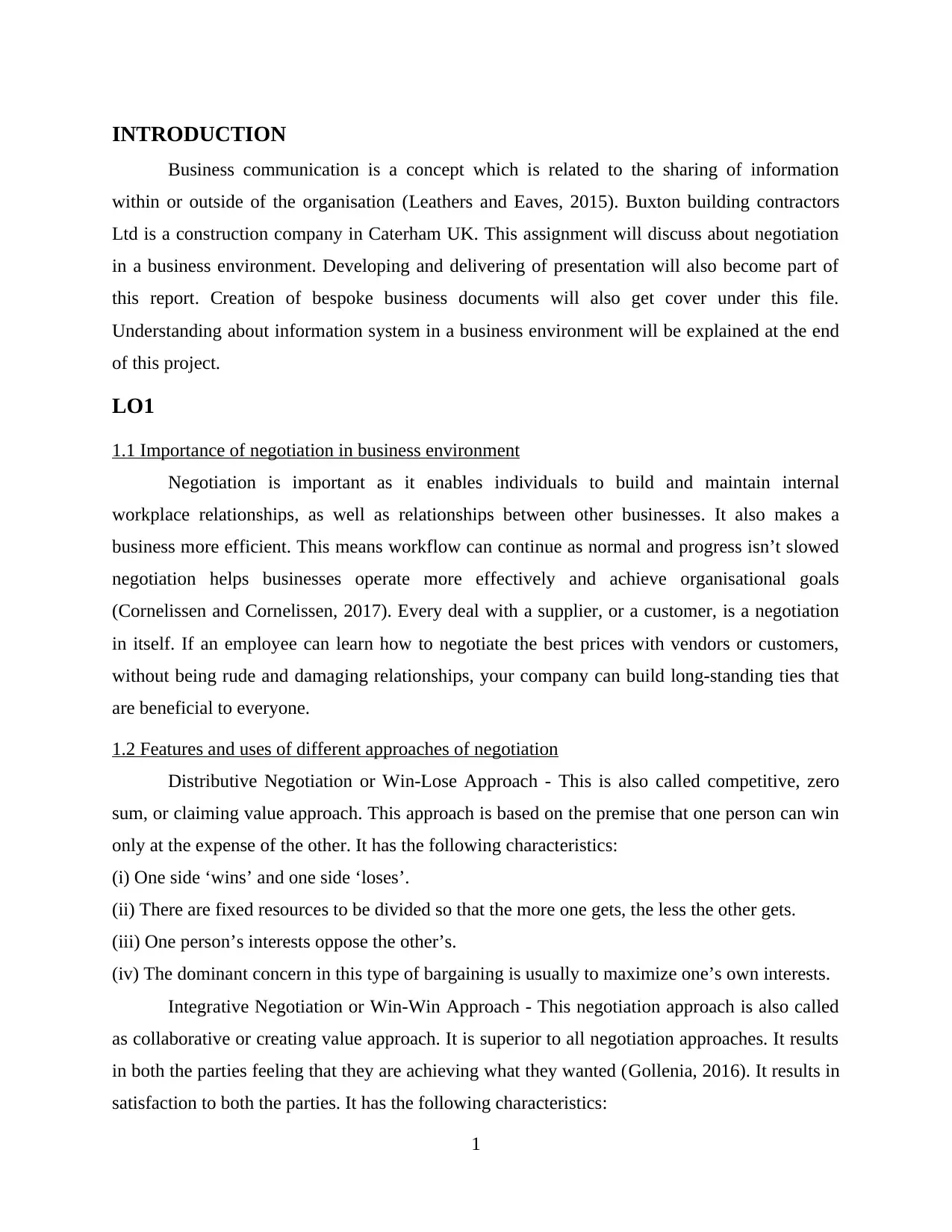
INTRODUCTION
Business communication is a concept which is related to the sharing of information
within or outside of the organisation (Leathers and Eaves, 2015). Buxton building contractors
Ltd is a construction company in Caterham UK. This assignment will discuss about negotiation
in a business environment. Developing and delivering of presentation will also become part of
this report. Creation of bespoke business documents will also get cover under this file.
Understanding about information system in a business environment will be explained at the end
of this project.
LO1
1.1 Importance of negotiation in business environment
Negotiation is important as it enables individuals to build and maintain internal
workplace relationships, as well as relationships between other businesses. It also makes a
business more efficient. This means workflow can continue as normal and progress isn’t slowed
negotiation helps businesses operate more effectively and achieve organisational goals
(Cornelissen and Cornelissen, 2017). Every deal with a supplier, or a customer, is a negotiation
in itself. If an employee can learn how to negotiate the best prices with vendors or customers,
without being rude and damaging relationships, your company can build long-standing ties that
are beneficial to everyone.
1.2 Features and uses of different approaches of negotiation
Distributive Negotiation or Win-Lose Approach - This is also called competitive, zero
sum, or claiming value approach. This approach is based on the premise that one person can win
only at the expense of the other. It has the following characteristics:
(i) One side ‘wins’ and one side ‘loses’.
(ii) There are fixed resources to be divided so that the more one gets, the less the other gets.
(iii) One person’s interests oppose the other’s.
(iv) The dominant concern in this type of bargaining is usually to maximize one’s own interests.
Integrative Negotiation or Win-Win Approach - This negotiation approach is also called
as collaborative or creating value approach. It is superior to all negotiation approaches. It results
in both the parties feeling that they are achieving what they wanted (Gollenia, 2016). It results in
satisfaction to both the parties. It has the following characteristics:
1
Business communication is a concept which is related to the sharing of information
within or outside of the organisation (Leathers and Eaves, 2015). Buxton building contractors
Ltd is a construction company in Caterham UK. This assignment will discuss about negotiation
in a business environment. Developing and delivering of presentation will also become part of
this report. Creation of bespoke business documents will also get cover under this file.
Understanding about information system in a business environment will be explained at the end
of this project.
LO1
1.1 Importance of negotiation in business environment
Negotiation is important as it enables individuals to build and maintain internal
workplace relationships, as well as relationships between other businesses. It also makes a
business more efficient. This means workflow can continue as normal and progress isn’t slowed
negotiation helps businesses operate more effectively and achieve organisational goals
(Cornelissen and Cornelissen, 2017). Every deal with a supplier, or a customer, is a negotiation
in itself. If an employee can learn how to negotiate the best prices with vendors or customers,
without being rude and damaging relationships, your company can build long-standing ties that
are beneficial to everyone.
1.2 Features and uses of different approaches of negotiation
Distributive Negotiation or Win-Lose Approach - This is also called competitive, zero
sum, or claiming value approach. This approach is based on the premise that one person can win
only at the expense of the other. It has the following characteristics:
(i) One side ‘wins’ and one side ‘loses’.
(ii) There are fixed resources to be divided so that the more one gets, the less the other gets.
(iii) One person’s interests oppose the other’s.
(iv) The dominant concern in this type of bargaining is usually to maximize one’s own interests.
Integrative Negotiation or Win-Win Approach - This negotiation approach is also called
as collaborative or creating value approach. It is superior to all negotiation approaches. It results
in both the parties feeling that they are achieving what they wanted (Gollenia, 2016). It results in
satisfaction to both the parties. It has the following characteristics:
1
⊘ This is a preview!⊘
Do you want full access?
Subscribe today to unlock all pages.

Trusted by 1+ million students worldwide
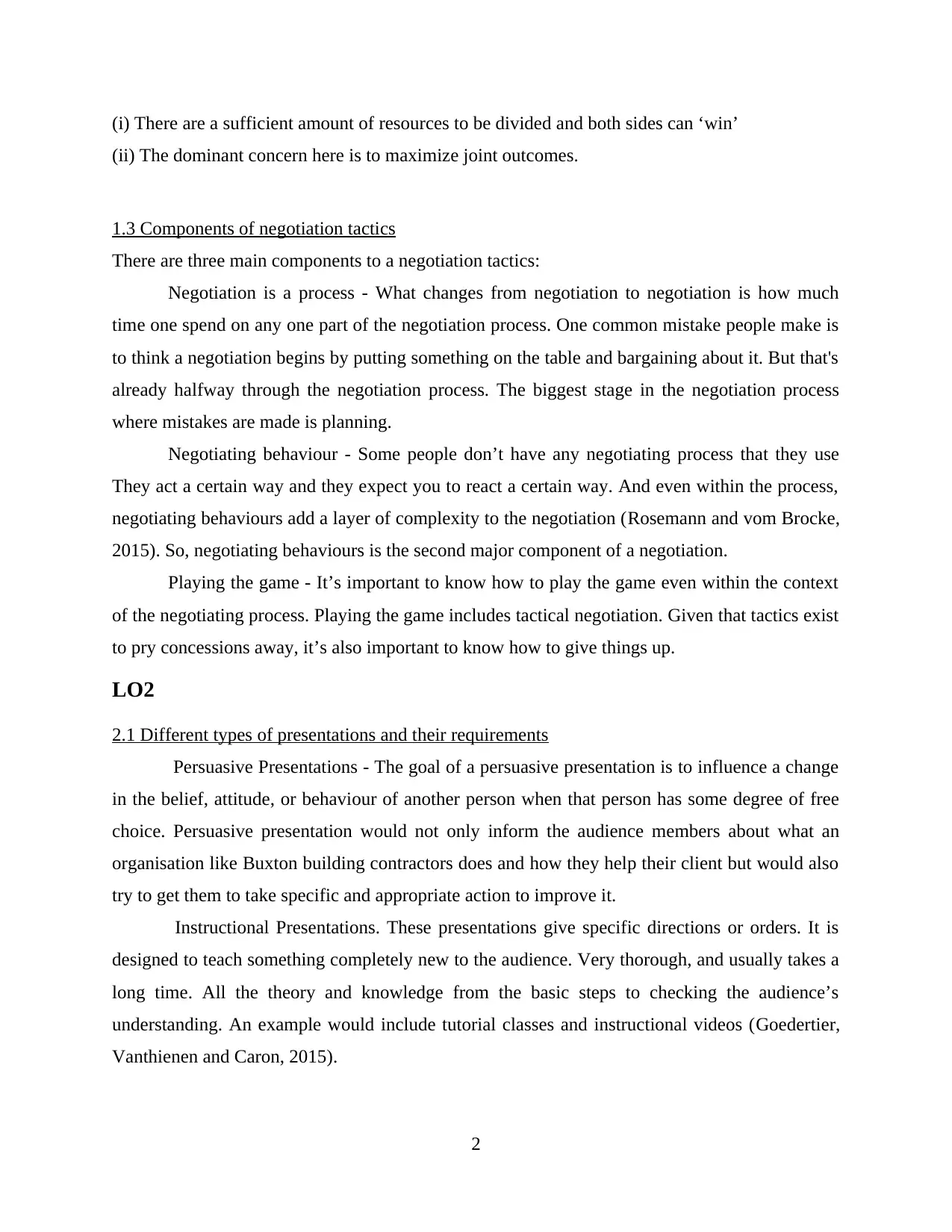
(i) There are a sufficient amount of resources to be divided and both sides can ‘win’
(ii) The dominant concern here is to maximize joint outcomes.
1.3 Components of negotiation tactics
There are three main components to a negotiation tactics:
Negotiation is a process - What changes from negotiation to negotiation is how much
time one spend on any one part of the negotiation process. One common mistake people make is
to think a negotiation begins by putting something on the table and bargaining about it. But that's
already halfway through the negotiation process. The biggest stage in the negotiation process
where mistakes are made is planning.
Negotiating behaviour - Some people don’t have any negotiating process that they use
They act a certain way and they expect you to react a certain way. And even within the process,
negotiating behaviours add a layer of complexity to the negotiation (Rosemann and vom Brocke,
2015). So, negotiating behaviours is the second major component of a negotiation.
Playing the game - It’s important to know how to play the game even within the context
of the negotiating process. Playing the game includes tactical negotiation. Given that tactics exist
to pry concessions away, it’s also important to know how to give things up.
LO2
2.1 Different types of presentations and their requirements
Persuasive Presentations - The goal of a persuasive presentation is to influence a change
in the belief, attitude, or behaviour of another person when that person has some degree of free
choice. Persuasive presentation would not only inform the audience members about what an
organisation like Buxton building contractors does and how they help their client but would also
try to get them to take specific and appropriate action to improve it.
Instructional Presentations. These presentations give specific directions or orders. It is
designed to teach something completely new to the audience. Very thorough, and usually takes a
long time. All the theory and knowledge from the basic steps to checking the audience’s
understanding. An example would include tutorial classes and instructional videos (Goedertier,
Vanthienen and Caron, 2015).
2
(ii) The dominant concern here is to maximize joint outcomes.
1.3 Components of negotiation tactics
There are three main components to a negotiation tactics:
Negotiation is a process - What changes from negotiation to negotiation is how much
time one spend on any one part of the negotiation process. One common mistake people make is
to think a negotiation begins by putting something on the table and bargaining about it. But that's
already halfway through the negotiation process. The biggest stage in the negotiation process
where mistakes are made is planning.
Negotiating behaviour - Some people don’t have any negotiating process that they use
They act a certain way and they expect you to react a certain way. And even within the process,
negotiating behaviours add a layer of complexity to the negotiation (Rosemann and vom Brocke,
2015). So, negotiating behaviours is the second major component of a negotiation.
Playing the game - It’s important to know how to play the game even within the context
of the negotiating process. Playing the game includes tactical negotiation. Given that tactics exist
to pry concessions away, it’s also important to know how to give things up.
LO2
2.1 Different types of presentations and their requirements
Persuasive Presentations - The goal of a persuasive presentation is to influence a change
in the belief, attitude, or behaviour of another person when that person has some degree of free
choice. Persuasive presentation would not only inform the audience members about what an
organisation like Buxton building contractors does and how they help their client but would also
try to get them to take specific and appropriate action to improve it.
Instructional Presentations. These presentations give specific directions or orders. It is
designed to teach something completely new to the audience. Very thorough, and usually takes a
long time. All the theory and knowledge from the basic steps to checking the audience’s
understanding. An example would include tutorial classes and instructional videos (Goedertier,
Vanthienen and Caron, 2015).
2
Paraphrase This Document
Need a fresh take? Get an instant paraphrase of this document with our AI Paraphraser
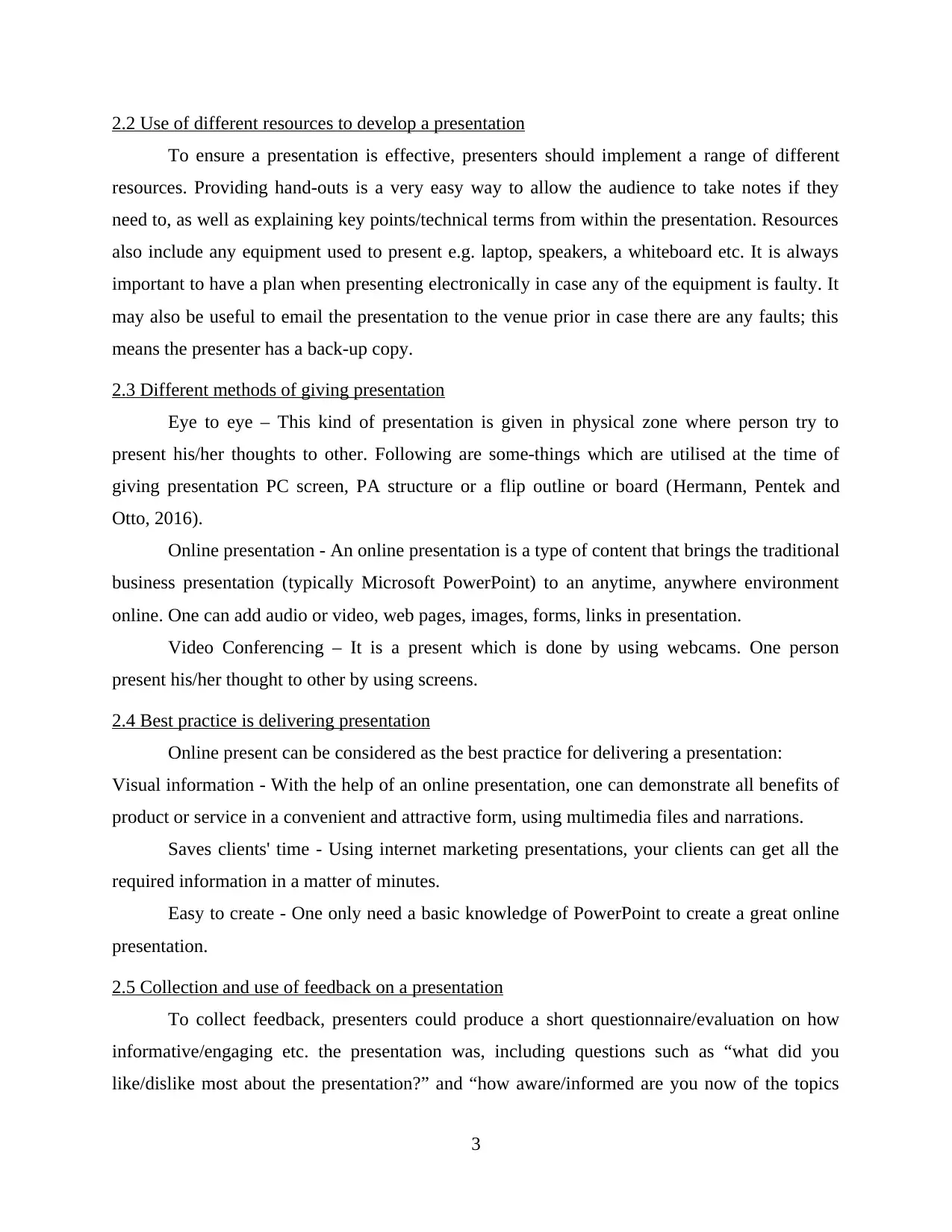
2.2 Use of different resources to develop a presentation
To ensure a presentation is effective, presenters should implement a range of different
resources. Providing hand-outs is a very easy way to allow the audience to take notes if they
need to, as well as explaining key points/technical terms from within the presentation. Resources
also include any equipment used to present e.g. laptop, speakers, a whiteboard etc. It is always
important to have a plan when presenting electronically in case any of the equipment is faulty. It
may also be useful to email the presentation to the venue prior in case there are any faults; this
means the presenter has a back-up copy.
2.3 Different methods of giving presentation
Eye to eye – This kind of presentation is given in physical zone where person try to
present his/her thoughts to other. Following are some-things which are utilised at the time of
giving presentation PC screen, PA structure or a flip outline or board (Hermann, Pentek and
Otto, 2016).
Online presentation - An online presentation is a type of content that brings the traditional
business presentation (typically Microsoft PowerPoint) to an anytime, anywhere environment
online. One can add audio or video, web pages, images, forms, links in presentation.
Video Conferencing – It is a present which is done by using webcams. One person
present his/her thought to other by using screens.
2.4 Best practice is delivering presentation
Online present can be considered as the best practice for delivering a presentation:
Visual information - With the help of an online presentation, one can demonstrate all benefits of
product or service in a convenient and attractive form, using multimedia files and narrations.
Saves clients' time - Using internet marketing presentations, your clients can get all the
required information in a matter of minutes.
Easy to create - One only need a basic knowledge of PowerPoint to create a great online
presentation.
2.5 Collection and use of feedback on a presentation
To collect feedback, presenters could produce a short questionnaire/evaluation on how
informative/engaging etc. the presentation was, including questions such as “what did you
like/dislike most about the presentation?” and “how aware/informed are you now of the topics
3
To ensure a presentation is effective, presenters should implement a range of different
resources. Providing hand-outs is a very easy way to allow the audience to take notes if they
need to, as well as explaining key points/technical terms from within the presentation. Resources
also include any equipment used to present e.g. laptop, speakers, a whiteboard etc. It is always
important to have a plan when presenting electronically in case any of the equipment is faulty. It
may also be useful to email the presentation to the venue prior in case there are any faults; this
means the presenter has a back-up copy.
2.3 Different methods of giving presentation
Eye to eye – This kind of presentation is given in physical zone where person try to
present his/her thoughts to other. Following are some-things which are utilised at the time of
giving presentation PC screen, PA structure or a flip outline or board (Hermann, Pentek and
Otto, 2016).
Online presentation - An online presentation is a type of content that brings the traditional
business presentation (typically Microsoft PowerPoint) to an anytime, anywhere environment
online. One can add audio or video, web pages, images, forms, links in presentation.
Video Conferencing – It is a present which is done by using webcams. One person
present his/her thought to other by using screens.
2.4 Best practice is delivering presentation
Online present can be considered as the best practice for delivering a presentation:
Visual information - With the help of an online presentation, one can demonstrate all benefits of
product or service in a convenient and attractive form, using multimedia files and narrations.
Saves clients' time - Using internet marketing presentations, your clients can get all the
required information in a matter of minutes.
Easy to create - One only need a basic knowledge of PowerPoint to create a great online
presentation.
2.5 Collection and use of feedback on a presentation
To collect feedback, presenters could produce a short questionnaire/evaluation on how
informative/engaging etc. the presentation was, including questions such as “what did you
like/dislike most about the presentation?” and “how aware/informed are you now of the topics
3
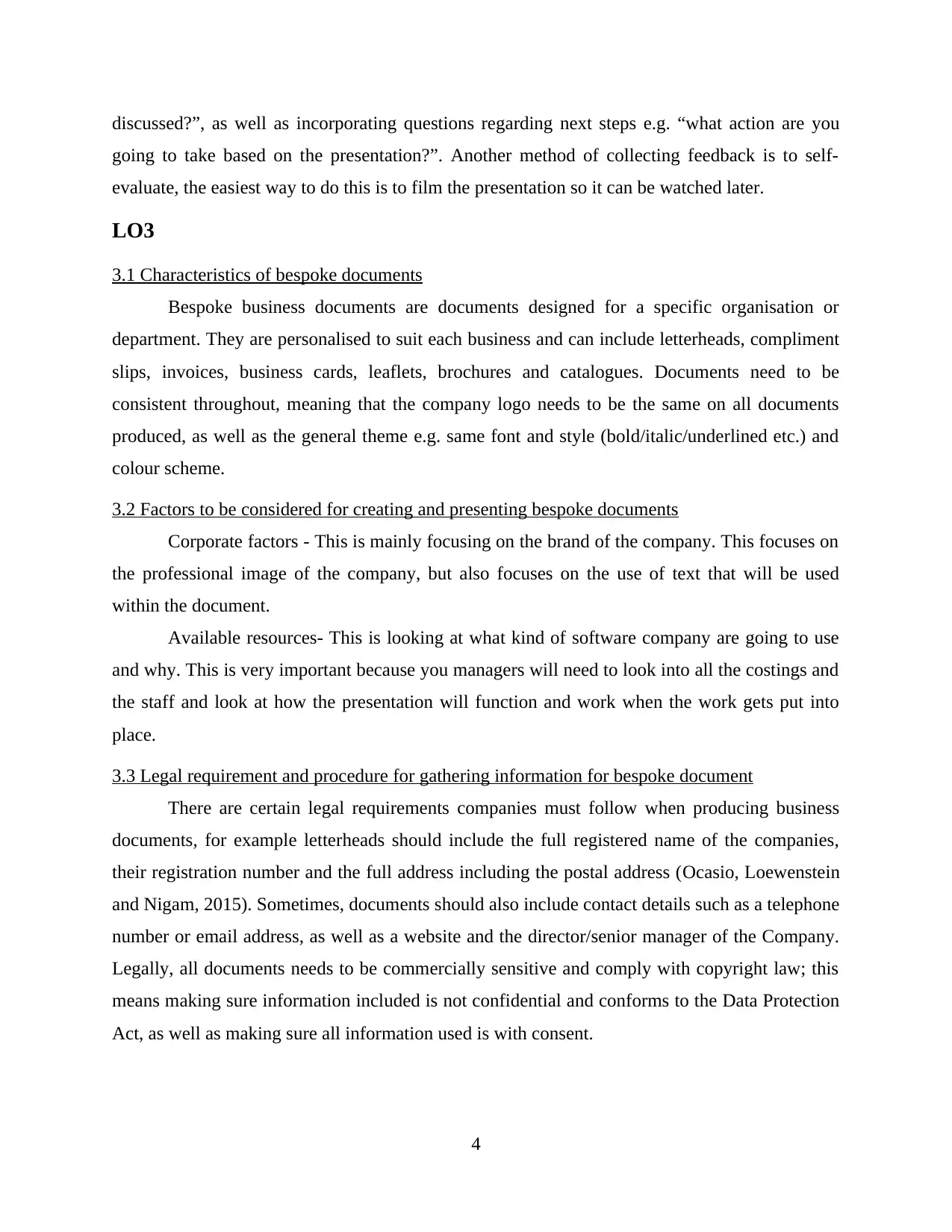
discussed?”, as well as incorporating questions regarding next steps e.g. “what action are you
going to take based on the presentation?”. Another method of collecting feedback is to self-
evaluate, the easiest way to do this is to film the presentation so it can be watched later.
LO3
3.1 Characteristics of bespoke documents
Bespoke business documents are documents designed for a specific organisation or
department. They are personalised to suit each business and can include letterheads, compliment
slips, invoices, business cards, leaflets, brochures and catalogues. Documents need to be
consistent throughout, meaning that the company logo needs to be the same on all documents
produced, as well as the general theme e.g. same font and style (bold/italic/underlined etc.) and
colour scheme.
3.2 Factors to be considered for creating and presenting bespoke documents
Corporate factors - This is mainly focusing on the brand of the company. This focuses on
the professional image of the company, but also focuses on the use of text that will be used
within the document.
Available resources- This is looking at what kind of software company are going to use
and why. This is very important because you managers will need to look into all the costings and
the staff and look at how the presentation will function and work when the work gets put into
place.
3.3 Legal requirement and procedure for gathering information for bespoke document
There are certain legal requirements companies must follow when producing business
documents, for example letterheads should include the full registered name of the companies,
their registration number and the full address including the postal address (Ocasio, Loewenstein
and Nigam, 2015). Sometimes, documents should also include contact details such as a telephone
number or email address, as well as a website and the director/senior manager of the Company.
Legally, all documents needs to be commercially sensitive and comply with copyright law; this
means making sure information included is not confidential and conforms to the Data Protection
Act, as well as making sure all information used is with consent.
4
going to take based on the presentation?”. Another method of collecting feedback is to self-
evaluate, the easiest way to do this is to film the presentation so it can be watched later.
LO3
3.1 Characteristics of bespoke documents
Bespoke business documents are documents designed for a specific organisation or
department. They are personalised to suit each business and can include letterheads, compliment
slips, invoices, business cards, leaflets, brochures and catalogues. Documents need to be
consistent throughout, meaning that the company logo needs to be the same on all documents
produced, as well as the general theme e.g. same font and style (bold/italic/underlined etc.) and
colour scheme.
3.2 Factors to be considered for creating and presenting bespoke documents
Corporate factors - This is mainly focusing on the brand of the company. This focuses on
the professional image of the company, but also focuses on the use of text that will be used
within the document.
Available resources- This is looking at what kind of software company are going to use
and why. This is very important because you managers will need to look into all the costings and
the staff and look at how the presentation will function and work when the work gets put into
place.
3.3 Legal requirement and procedure for gathering information for bespoke document
There are certain legal requirements companies must follow when producing business
documents, for example letterheads should include the full registered name of the companies,
their registration number and the full address including the postal address (Ocasio, Loewenstein
and Nigam, 2015). Sometimes, documents should also include contact details such as a telephone
number or email address, as well as a website and the director/senior manager of the Company.
Legally, all documents needs to be commercially sensitive and comply with copyright law; this
means making sure information included is not confidential and conforms to the Data Protection
Act, as well as making sure all information used is with consent.
4
⊘ This is a preview!⊘
Do you want full access?
Subscribe today to unlock all pages.

Trusted by 1+ million students worldwide
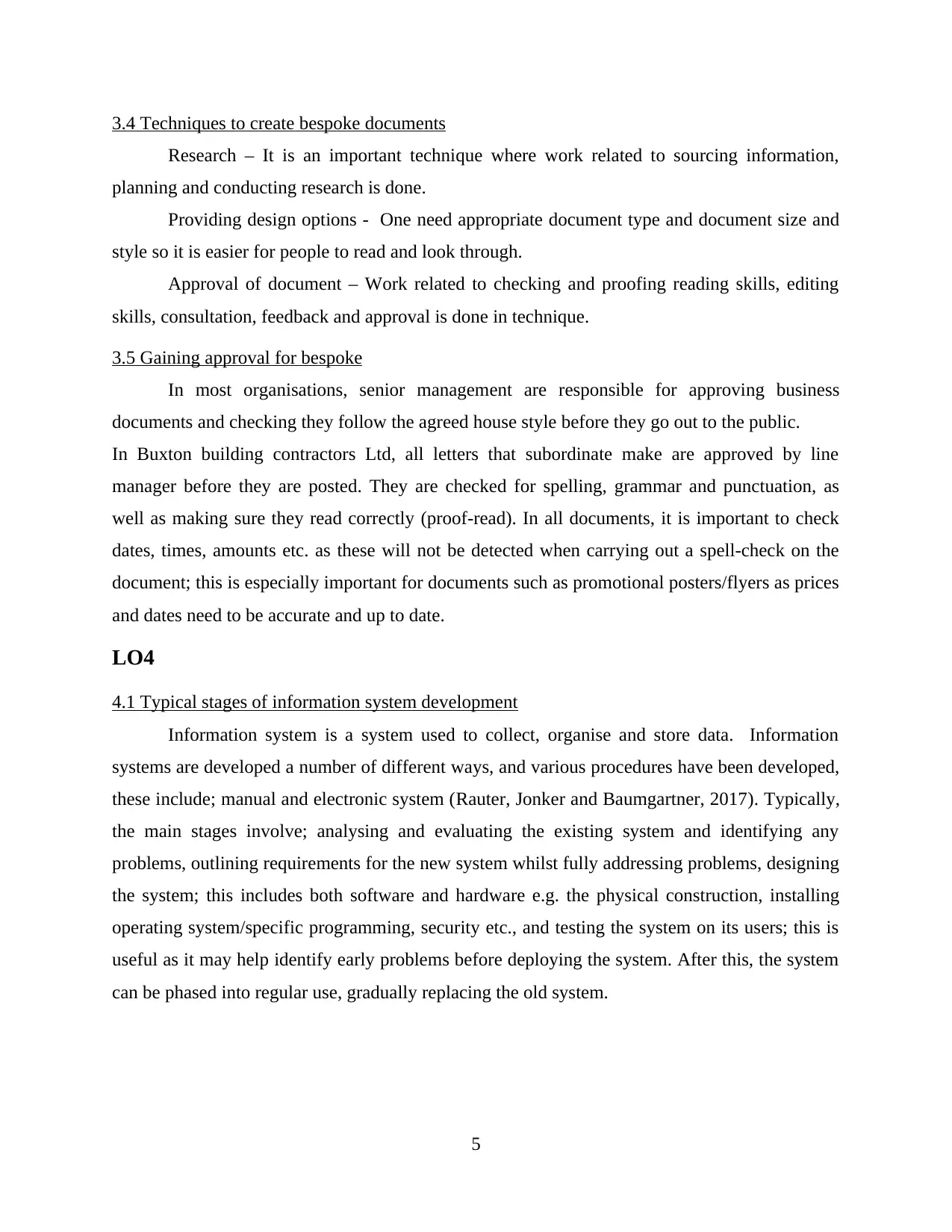
3.4 Techniques to create bespoke documents
Research – It is an important technique where work related to sourcing information,
planning and conducting research is done.
Providing design options - One need appropriate document type and document size and
style so it is easier for people to read and look through.
Approval of document – Work related to checking and proofing reading skills, editing
skills, consultation, feedback and approval is done in technique.
3.5 Gaining approval for bespoke
In most organisations, senior management are responsible for approving business
documents and checking they follow the agreed house style before they go out to the public.
In Buxton building contractors Ltd, all letters that subordinate make are approved by line
manager before they are posted. They are checked for spelling, grammar and punctuation, as
well as making sure they read correctly (proof-read). In all documents, it is important to check
dates, times, amounts etc. as these will not be detected when carrying out a spell-check on the
document; this is especially important for documents such as promotional posters/flyers as prices
and dates need to be accurate and up to date.
LO4
4.1 Typical stages of information system development
Information system is a system used to collect, organise and store data. Information
systems are developed a number of different ways, and various procedures have been developed,
these include; manual and electronic system (Rauter, Jonker and Baumgartner, 2017). Typically,
the main stages involve; analysing and evaluating the existing system and identifying any
problems, outlining requirements for the new system whilst fully addressing problems, designing
the system; this includes both software and hardware e.g. the physical construction, installing
operating system/specific programming, security etc., and testing the system on its users; this is
useful as it may help identify early problems before deploying the system. After this, the system
can be phased into regular use, gradually replacing the old system.
5
Research – It is an important technique where work related to sourcing information,
planning and conducting research is done.
Providing design options - One need appropriate document type and document size and
style so it is easier for people to read and look through.
Approval of document – Work related to checking and proofing reading skills, editing
skills, consultation, feedback and approval is done in technique.
3.5 Gaining approval for bespoke
In most organisations, senior management are responsible for approving business
documents and checking they follow the agreed house style before they go out to the public.
In Buxton building contractors Ltd, all letters that subordinate make are approved by line
manager before they are posted. They are checked for spelling, grammar and punctuation, as
well as making sure they read correctly (proof-read). In all documents, it is important to check
dates, times, amounts etc. as these will not be detected when carrying out a spell-check on the
document; this is especially important for documents such as promotional posters/flyers as prices
and dates need to be accurate and up to date.
LO4
4.1 Typical stages of information system development
Information system is a system used to collect, organise and store data. Information
systems are developed a number of different ways, and various procedures have been developed,
these include; manual and electronic system (Rauter, Jonker and Baumgartner, 2017). Typically,
the main stages involve; analysing and evaluating the existing system and identifying any
problems, outlining requirements for the new system whilst fully addressing problems, designing
the system; this includes both software and hardware e.g. the physical construction, installing
operating system/specific programming, security etc., and testing the system on its users; this is
useful as it may help identify early problems before deploying the system. After this, the system
can be phased into regular use, gradually replacing the old system.
5
Paraphrase This Document
Need a fresh take? Get an instant paraphrase of this document with our AI Paraphraser
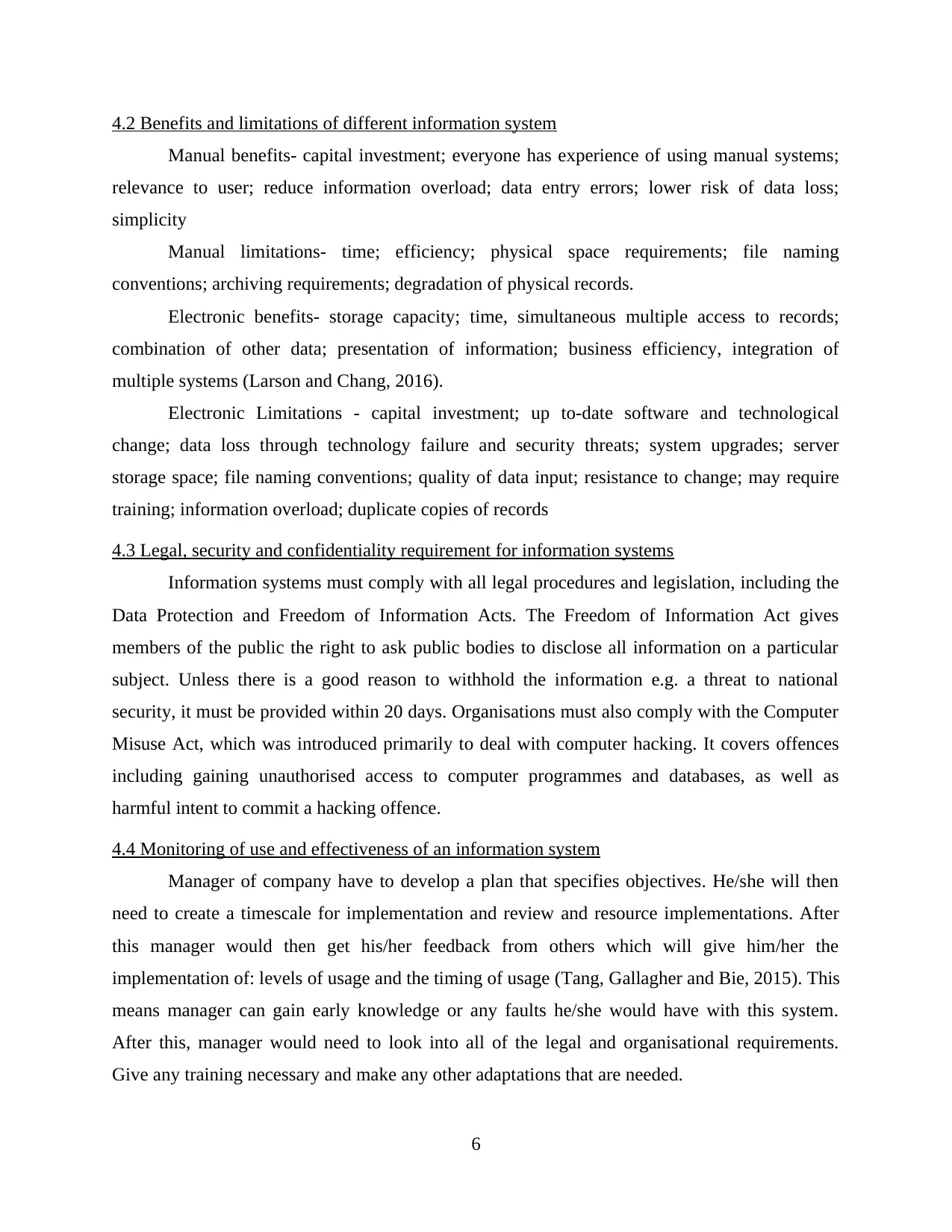
4.2 Benefits and limitations of different information system
Manual benefits- capital investment; everyone has experience of using manual systems;
relevance to user; reduce information overload; data entry errors; lower risk of data loss;
simplicity
Manual limitations- time; efficiency; physical space requirements; file naming
conventions; archiving requirements; degradation of physical records.
Electronic benefits- storage capacity; time, simultaneous multiple access to records;
combination of other data; presentation of information; business efficiency, integration of
multiple systems (Larson and Chang, 2016).
Electronic Limitations - capital investment; up to-date software and technological
change; data loss through technology failure and security threats; system upgrades; server
storage space; file naming conventions; quality of data input; resistance to change; may require
training; information overload; duplicate copies of records
4.3 Legal, security and confidentiality requirement for information systems
Information systems must comply with all legal procedures and legislation, including the
Data Protection and Freedom of Information Acts. The Freedom of Information Act gives
members of the public the right to ask public bodies to disclose all information on a particular
subject. Unless there is a good reason to withhold the information e.g. a threat to national
security, it must be provided within 20 days. Organisations must also comply with the Computer
Misuse Act, which was introduced primarily to deal with computer hacking. It covers offences
including gaining unauthorised access to computer programmes and databases, as well as
harmful intent to commit a hacking offence.
4.4 Monitoring of use and effectiveness of an information system
Manager of company have to develop a plan that specifies objectives. He/she will then
need to create a timescale for implementation and review and resource implementations. After
this manager would then get his/her feedback from others which will give him/her the
implementation of: levels of usage and the timing of usage (Tang, Gallagher and Bie, 2015). This
means manager can gain early knowledge or any faults he/she would have with this system.
After this, manager would need to look into all of the legal and organisational requirements.
Give any training necessary and make any other adaptations that are needed.
6
Manual benefits- capital investment; everyone has experience of using manual systems;
relevance to user; reduce information overload; data entry errors; lower risk of data loss;
simplicity
Manual limitations- time; efficiency; physical space requirements; file naming
conventions; archiving requirements; degradation of physical records.
Electronic benefits- storage capacity; time, simultaneous multiple access to records;
combination of other data; presentation of information; business efficiency, integration of
multiple systems (Larson and Chang, 2016).
Electronic Limitations - capital investment; up to-date software and technological
change; data loss through technology failure and security threats; system upgrades; server
storage space; file naming conventions; quality of data input; resistance to change; may require
training; information overload; duplicate copies of records
4.3 Legal, security and confidentiality requirement for information systems
Information systems must comply with all legal procedures and legislation, including the
Data Protection and Freedom of Information Acts. The Freedom of Information Act gives
members of the public the right to ask public bodies to disclose all information on a particular
subject. Unless there is a good reason to withhold the information e.g. a threat to national
security, it must be provided within 20 days. Organisations must also comply with the Computer
Misuse Act, which was introduced primarily to deal with computer hacking. It covers offences
including gaining unauthorised access to computer programmes and databases, as well as
harmful intent to commit a hacking offence.
4.4 Monitoring of use and effectiveness of an information system
Manager of company have to develop a plan that specifies objectives. He/she will then
need to create a timescale for implementation and review and resource implementations. After
this manager would then get his/her feedback from others which will give him/her the
implementation of: levels of usage and the timing of usage (Tang, Gallagher and Bie, 2015). This
means manager can gain early knowledge or any faults he/she would have with this system.
After this, manager would need to look into all of the legal and organisational requirements.
Give any training necessary and make any other adaptations that are needed.
6
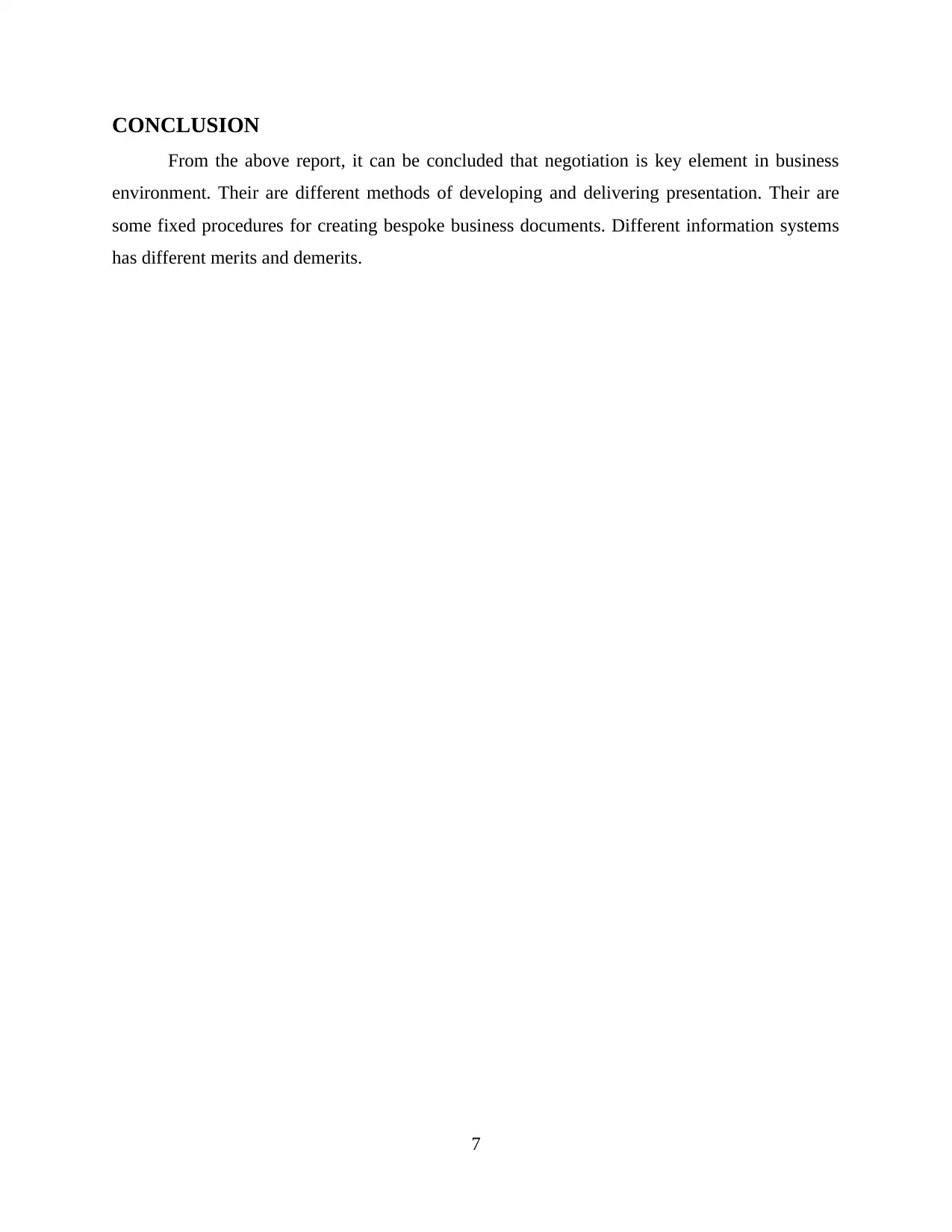
CONCLUSION
From the above report, it can be concluded that negotiation is key element in business
environment. Their are different methods of developing and delivering presentation. Their are
some fixed procedures for creating bespoke business documents. Different information systems
has different merits and demerits.
7
From the above report, it can be concluded that negotiation is key element in business
environment. Their are different methods of developing and delivering presentation. Their are
some fixed procedures for creating bespoke business documents. Different information systems
has different merits and demerits.
7
⊘ This is a preview!⊘
Do you want full access?
Subscribe today to unlock all pages.

Trusted by 1+ million students worldwide
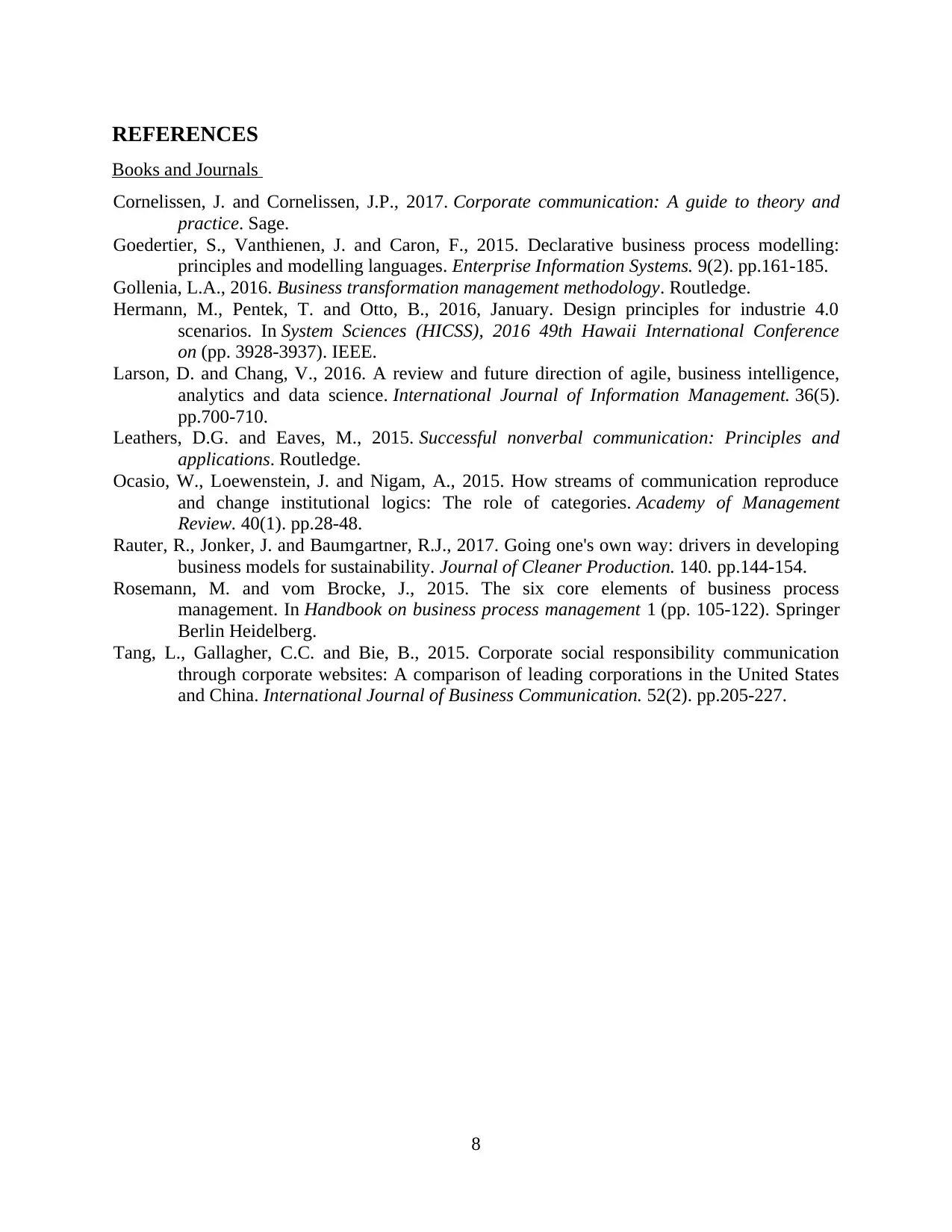
REFERENCES
Books and Journals
Cornelissen, J. and Cornelissen, J.P., 2017. Corporate communication: A guide to theory and
practice. Sage.
Goedertier, S., Vanthienen, J. and Caron, F., 2015. Declarative business process modelling:
principles and modelling languages. Enterprise Information Systems. 9(2). pp.161-185.
Gollenia, L.A., 2016. Business transformation management methodology. Routledge.
Hermann, M., Pentek, T. and Otto, B., 2016, January. Design principles for industrie 4.0
scenarios. In System Sciences (HICSS), 2016 49th Hawaii International Conference
on (pp. 3928-3937). IEEE.
Larson, D. and Chang, V., 2016. A review and future direction of agile, business intelligence,
analytics and data science. International Journal of Information Management. 36(5).
pp.700-710.
Leathers, D.G. and Eaves, M., 2015. Successful nonverbal communication: Principles and
applications. Routledge.
Ocasio, W., Loewenstein, J. and Nigam, A., 2015. How streams of communication reproduce
and change institutional logics: The role of categories. Academy of Management
Review. 40(1). pp.28-48.
Rauter, R., Jonker, J. and Baumgartner, R.J., 2017. Going one's own way: drivers in developing
business models for sustainability. Journal of Cleaner Production. 140. pp.144-154.
Rosemann, M. and vom Brocke, J., 2015. The six core elements of business process
management. In Handbook on business process management 1 (pp. 105-122). Springer
Berlin Heidelberg.
Tang, L., Gallagher, C.C. and Bie, B., 2015. Corporate social responsibility communication
through corporate websites: A comparison of leading corporations in the United States
and China. International Journal of Business Communication. 52(2). pp.205-227.
8
Books and Journals
Cornelissen, J. and Cornelissen, J.P., 2017. Corporate communication: A guide to theory and
practice. Sage.
Goedertier, S., Vanthienen, J. and Caron, F., 2015. Declarative business process modelling:
principles and modelling languages. Enterprise Information Systems. 9(2). pp.161-185.
Gollenia, L.A., 2016. Business transformation management methodology. Routledge.
Hermann, M., Pentek, T. and Otto, B., 2016, January. Design principles for industrie 4.0
scenarios. In System Sciences (HICSS), 2016 49th Hawaii International Conference
on (pp. 3928-3937). IEEE.
Larson, D. and Chang, V., 2016. A review and future direction of agile, business intelligence,
analytics and data science. International Journal of Information Management. 36(5).
pp.700-710.
Leathers, D.G. and Eaves, M., 2015. Successful nonverbal communication: Principles and
applications. Routledge.
Ocasio, W., Loewenstein, J. and Nigam, A., 2015. How streams of communication reproduce
and change institutional logics: The role of categories. Academy of Management
Review. 40(1). pp.28-48.
Rauter, R., Jonker, J. and Baumgartner, R.J., 2017. Going one's own way: drivers in developing
business models for sustainability. Journal of Cleaner Production. 140. pp.144-154.
Rosemann, M. and vom Brocke, J., 2015. The six core elements of business process
management. In Handbook on business process management 1 (pp. 105-122). Springer
Berlin Heidelberg.
Tang, L., Gallagher, C.C. and Bie, B., 2015. Corporate social responsibility communication
through corporate websites: A comparison of leading corporations in the United States
and China. International Journal of Business Communication. 52(2). pp.205-227.
8
1 out of 10
Related Documents
Your All-in-One AI-Powered Toolkit for Academic Success.
+13062052269
info@desklib.com
Available 24*7 on WhatsApp / Email
![[object Object]](/_next/static/media/star-bottom.7253800d.svg)
Unlock your academic potential
Copyright © 2020–2025 A2Z Services. All Rights Reserved. Developed and managed by ZUCOL.





